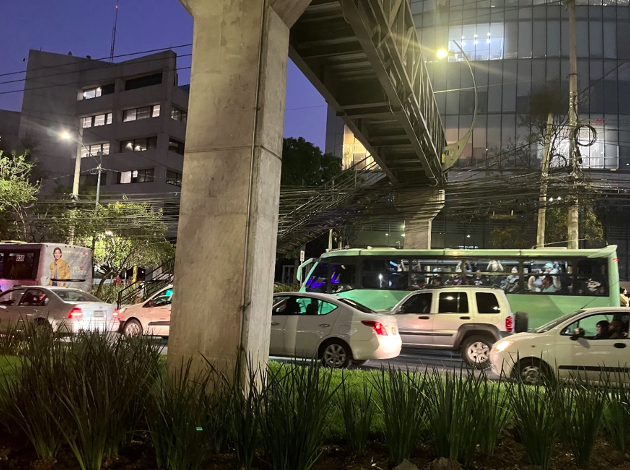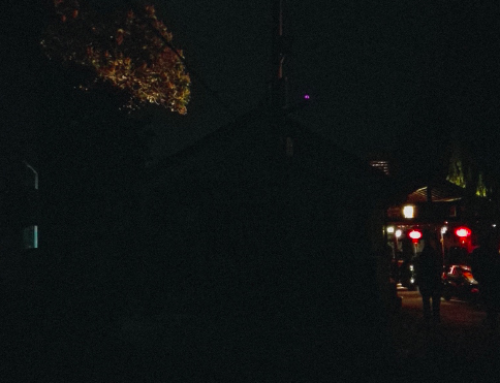
Mexico City freeway(a). Photo by the author

Mexico City freeway(b). Photo by the author
In February of this year, I spent a week in Mexico City, the non-Canadian city I have visited more often than any other. The hosts of the conference I was attending (on North American Studies) put me up in a hotel across from the Peri-Sur shopping center, conveniently close to the campus of the Universidad Nacional Autónoma de México, where the event was held. This was far from the northern neighborhoods in which I thought I’d want to pass my evenings and other free time. I spent at least 90 minutes each day in Ubers, going up and down the main boulevards and expressways, from Peri-Sur to the Centro Historica or to the Colonia Roma neighborhoods, then back. With this “flash essay” in the back of my mind, I had imagined taking photos of busy sociability at dusk, in the Centro Historico or perhaps in a park.
But almost every day, it seems, dusk fell while I was in a car moving slowly through traffic. Unexpectedly, these became many of my favorite moments of the week. A former student of mine who attended the conference, and was in the city for the first time, observed that Mexico City drivers rarely lost their tempers or shouted at each other. Whether this was empirically accurate or not, the calm efficiency of those who drove me was a striking contrast to the rarely contained impatience and anger of taxi drivers in Montreal, where I live. (I was reminded of the calm that persists amidst calamity in the recent Mexican documentary film Midnight Family, about night-time ambulance drivers in Mexico City[1].) In Mexico City, the drivers, noting my age, would often switch the music to something older or softer. (I was flattered when one of them put on an eighties station.) I was the one who muttered when another car tried to usurp our space or came too close. Largely, though, and unexpectedly, the predominant experience of these rides at dusk was visual.
If dusk is a property of the lighted sky, from my car it was only visible in the brief gaps of urban infrastructure. I was almost always riding under overhead expressways (like the famous Segundo Piso) or going along avenues overlaid with so many overhead bridges that they seemed to form a ceiling. Variations in illumination were erratic, dependent on whatever overlay of commercial exterior signage, interior bus lighting, and reflecting car lights marked a given point along the route. Much of the time, dusk arrived as if it were coloring in gaps in the landscape, filling the space between tree branches or the open corners between concrete girders and overpasses.
Amidst all this visual busyness, it was difficult to decide when dusk was in full form. I was easily deceived by the outlines of blue-gray buildings, whose tones might betray the coming of night or merely communicate their 24-hour drabness.
Travel sites will tell you about the best places to see the sunset in Mexico City (the 45-story Torre Latinoamericana, or some hotel rooftops). Long encrusted prejudices suggest that ideas of twilight or sunset are meaningless in a city known for its pollution, for what Gandy calls a “technologically induced perpetual twilight[2].” While I never saw the sun set, dusk snuck into my visual field and carried out its transformations. After a week of these trips, I thought I could guess the time at any given moment.
Those who write in aesthetic terms about dusk (or the arrival of night) will often speak of its capacity to erase forms, to blur distinctions of color and shape, to flatten the visual field. To be sure, on my twilight rides, buildings at a distance sometimes seemed to join together, the spaces between them disappearing as they formed what sometimes seemed like fortress walls protecting the avenues or expressways on which I was traveling. More typically, however, dusk laid bare what Armengaud and others have called the infrastructural city[3], the city of networked conduits. With the coming of dusk, the textual inscriptions and graphic design of overhead crossways or building facades receded into illegibility while patterns of interconnection moved to the forefront.
Notes:
[1] Midnight Family, 2019, directed by Luke Lorentzen, Mexico, 81 minutes.
[2] Matthew Gandy, “Negative Luminescence,” Annals of the American Association of Geographers (107(5), 2017), 1091.
[3] Matthias Armengaud, “The Infrastructural Nature of the Nightscape: Night as revealing of the large-scale, of the networked territory,” in Nightscapes/Paisajes nocturnos/Nocturnal Landscapes, Marc Armengaud, Matthias Armengaud, Alessandra Cianchetta eds. (Barcelona: Editorial Gustavo Gili, 2009), 65-103.
Will Straw is James McGill Professor of Urban Media Studies at McGill University in Montreal. His recent work focuses on cultures of the urban night.
Cite As: Straw, Will. 2023 “Twilight Riding in Mexico City” In “Flash Ethnography: Dusk” Aaron Hames and Derek Pardue, eds., American Ethnologist website, June 20 2023 https://americanethnologist.org/online-content/collections/dusk-collection/twilight-riding-in-mexico-city/




